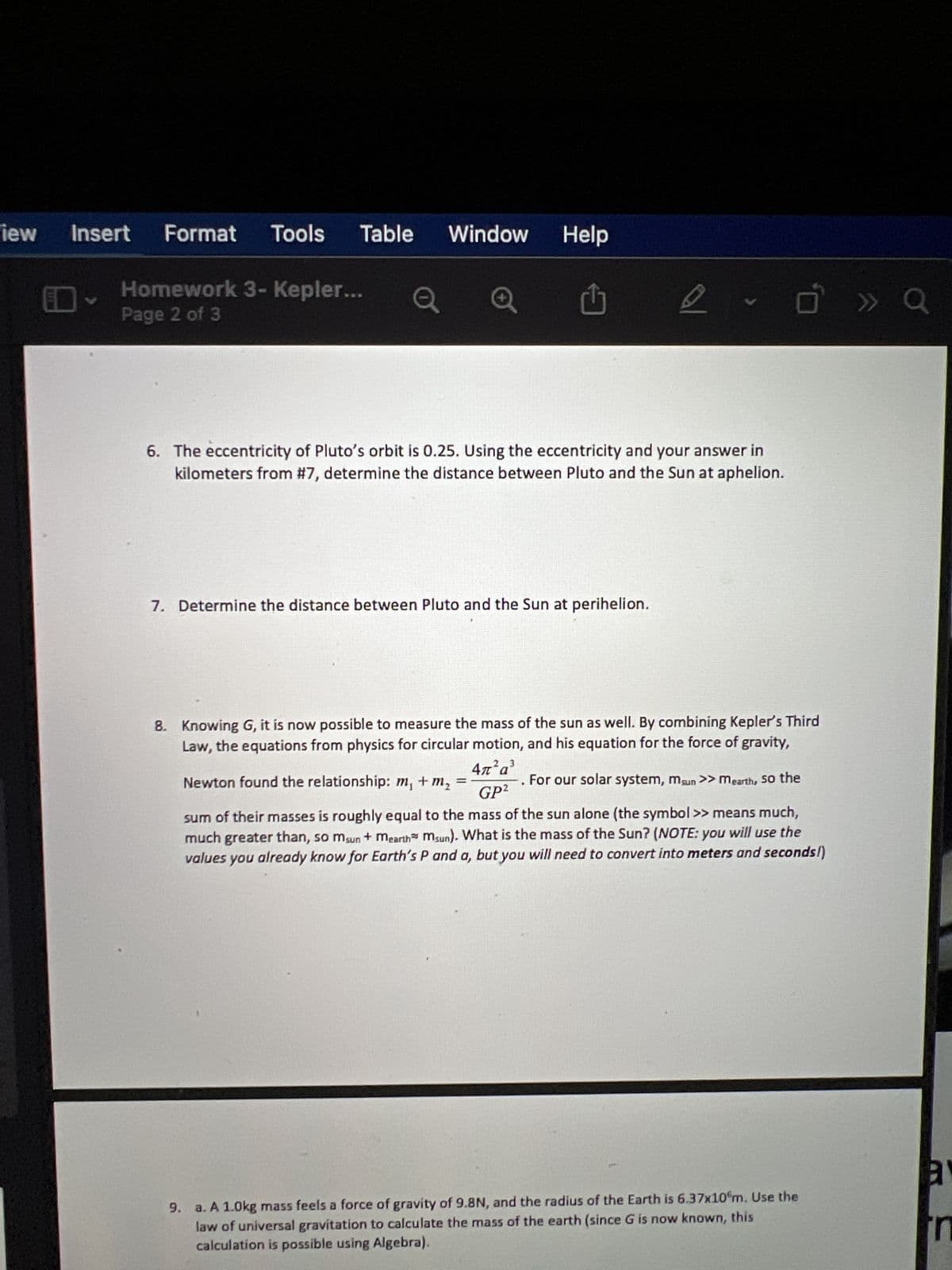6. The eccentricity of Pluto's orbit is 0.25. Using the eccentricity and your answer in kilometers from #7, determine the distance between Pluto and the Sun at aphelion.
6. The eccentricity of Pluto's orbit is 0.25. Using the eccentricity and your answer in kilometers from #7, determine the distance between Pluto and the Sun at aphelion.
Applications and Investigations in Earth Science (9th Edition)
9th Edition
ISBN:9780134746241
Author:Edward J. Tarbuck, Frederick K. Lutgens, Dennis G. Tasa
Publisher:Edward J. Tarbuck, Frederick K. Lutgens, Dennis G. Tasa
Chapter1: The Study Of Minerals
Section: Chapter Questions
Problem 1LR
Related questions
Question

Transcribed Image Text:iew
Insert Format Tools Table Window Help
Homework 3- Kepler...
Page 2 of 3
2 . Ö » Q
6. The eccentricity of Pluto's orbit is 0.25. Using the eccentricity and your answer in
kilometers from #7, determine the distance between Pluto and the Sun at aphelion.
7. Determine the distance between Pluto and the Sun at perihelion.
8. Knowing G, it is now possible to measure the mass of the sun as well. By combining Kepler's Third
Law, the equations from physics for circular motion, and his equation for the force of gravity,
Newton found the relationship: m, + m₂
4π²a³
GP²
For our solar system, mun >> Mearth, so the
sum of their masses is roughly equal to the mass of the sun alone (the symbol >> means much,
much greater than, so msun + mearth Msun). What is the mass of the Sun? (NOTE: you will use the
values you already know for Earth's P and a, but you will need to convert into meters and seconds!)
9. a. A 1.0kg mass feels a force of gravity of 9.8N, and the radius of the Earth is 6.37x10 m. Use the
law of universal gravitation to calculate the mass of the earth (since G is now known, this
calculation is possible using Algebra).
a
n
Expert Solution
This question has been solved!
Explore an expertly crafted, step-by-step solution for a thorough understanding of key concepts.
This is a popular solution!
Trending now
This is a popular solution!
Step by step
Solved in 2 steps with 1 images

Recommended textbooks for you

Applications and Investigations in Earth Science …
Earth Science
ISBN:
9780134746241
Author:
Edward J. Tarbuck, Frederick K. Lutgens, Dennis G. Tasa
Publisher:
PEARSON

Exercises for Weather & Climate (9th Edition)
Earth Science
ISBN:
9780134041360
Author:
Greg Carbone
Publisher:
PEARSON

Environmental Science
Earth Science
ISBN:
9781260153125
Author:
William P Cunningham Prof., Mary Ann Cunningham Professor
Publisher:
McGraw-Hill Education

Applications and Investigations in Earth Science …
Earth Science
ISBN:
9780134746241
Author:
Edward J. Tarbuck, Frederick K. Lutgens, Dennis G. Tasa
Publisher:
PEARSON

Exercises for Weather & Climate (9th Edition)
Earth Science
ISBN:
9780134041360
Author:
Greg Carbone
Publisher:
PEARSON

Environmental Science
Earth Science
ISBN:
9781260153125
Author:
William P Cunningham Prof., Mary Ann Cunningham Professor
Publisher:
McGraw-Hill Education

Earth Science (15th Edition)
Earth Science
ISBN:
9780134543536
Author:
Edward J. Tarbuck, Frederick K. Lutgens, Dennis G. Tasa
Publisher:
PEARSON

Environmental Science (MindTap Course List)
Earth Science
ISBN:
9781337569613
Author:
G. Tyler Miller, Scott Spoolman
Publisher:
Cengage Learning

Physical Geology
Earth Science
ISBN:
9781259916823
Author:
Plummer, Charles C., CARLSON, Diane H., Hammersley, Lisa
Publisher:
Mcgraw-hill Education,